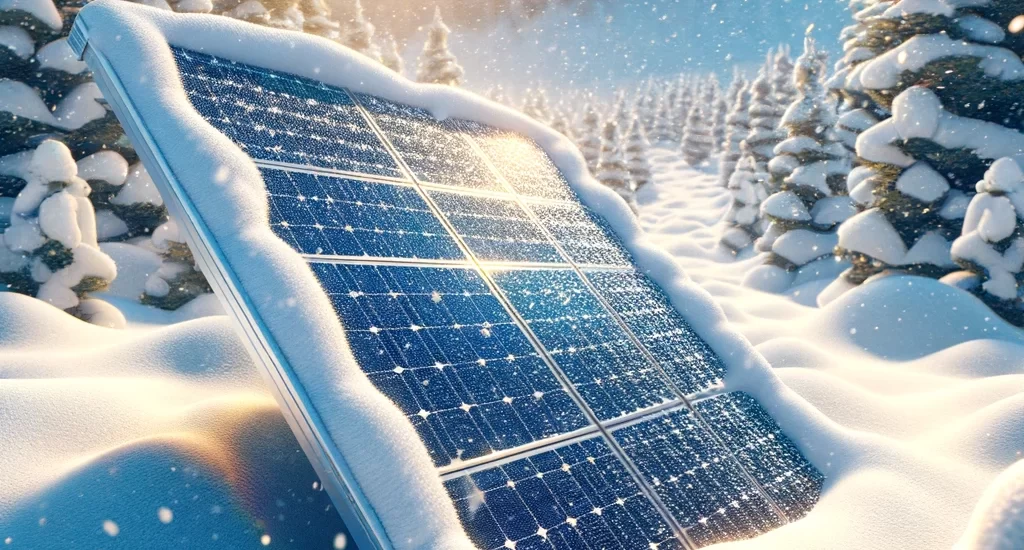Introduction: Unveiling Solar Power’s Winter Performance
As spring arrives, it’s easy to forget the winter questions that often come up about solar panels, like “Do they even work in winter?” It’s a fair question, especially for those eyeing solar power as a steadfast ally in their quest for green energy. This article tackles that curiosity head-on. We’re diving into the heart of how solar panels fare when the days are short and the air is cold. From debunking myths to highlighting how solar technology stands up to winter’s challenge, join us in uncovering the true performance of solar panels throughout the frostier months. Let’s clear the air and ensure that when winter rolls around again, you know exactly what to expect from your solar setup.
The Basics of Solar Panel Operation in Cold Weather
Solar panels are designed to convert sunlight into electricity, and their operation is surprisingly resilient in cold weather conditions. Contrary to popular belief, solar panels can perform more efficiently in colder temperatures due to the properties of the semiconductor materials used in their construction. As the temperature decreases, the electrical resistance of these materials drops, allowing the panels to produce electricity more efficiently. However, the amount of sunlight captured during winter months can be less due to shorter daylight hours, impacting overall energy production. It’s essential to understand that while cold temperatures might enhance panel efficiency, the actual energy output depends on the availability of sunlight, which varies with geographic location and season.
Myth Busting: Solar Panels and Snowfall
A common misconception is that snow significantly hinders the performance of solar panels. While heavy snowfall can cover panels and temporarily reduce their output, several factors mitigate this effect. First, solar panels are installed at an angle, helping snow to slide off more easily, especially when the sun melts the lower layers of the snow. Moreover, the dark surface of the panels can absorb heat from the sun, aiding in the melting process. Additionally, the reflection of sunlight off the snow (albedo effect) can actually increase the amount of light hitting the panels from reflected surfaces, potentially boosting their output under certain conditions. It’s also worth noting that most solar panel installations are calculated with seasonal weather patterns in mind, ensuring year-round energy efficiency despite occasional snow coverage.
The Surprising Benefits of Cold Temperatures on Solar Efficiency
Cold temperatures can have a beneficial effect on solar panel efficiency. Solar cells, which are the critical component of solar panels, operate through the photovoltaic effect where sunlight is converted into electricity. The efficiency of this process can increase in colder temperatures, as lower temperatures reduce the resistance in the electrical circuitry within the solar cells. This means that on bright, cold days, a solar panel could produce more electricity than on hot, sunny days. This counterintuitive fact highlights the importance of considering geographical and seasonal factors when evaluating the potential performance of solar energy systems.
Daylight Duration vs. Solar Energy Production
While solar panels might be more efficient in cold temperatures, the shorter daylight hours during winter months can pose a challenge to solar energy production. The angle of the sun’s path across the sky changes with the seasons, resulting in fewer hours of daylight and a lower angle of sunlight hitting the panels in winter. This change can reduce the amount of solar energy that panels can produce. However, strategies such as adjusting the tilt of solar panels to optimise their angle relative to the sun’s position can help mitigate this effect. Moreover, modern solar panels are designed to capture diffuse sunlight (solar radiation that has been scattered by molecules and particles in the atmosphere) effectively, which can help maintain energy production even on overcast days.
Strategies for Maximising Solar Panel Output in Winter
To optimise solar panel performance during the winter months, several strategies can be employed. Firstly, adjusting the tilt of the panels can significantly impact their ability to capture sunlight efficiently when the sun is lower in the sky. Panels should be angled more steeply to match the sun’s lower trajectory. Additionally, ensuring that panels are free of snow and debris can prevent unnecessary blockages of sunlight. Technologies such as automatic snow melt systems or coatings that repel snow and ice can be useful in maintaining clear panels. Implementing solar tracking systems that adjust the panel’s angle throughout the day can also enhance sunlight capture during shorter daylight hours, further increasing energy production.
Snow and Solar: Handling Accumulation and Reflectivity
Snow accumulation on solar panels can temporarily reduce their output, but it’s not all negative. Snow has a high albedo effect, meaning it can reflect sunlight onto panels, potentially increasing their efficiency under the right conditions. To manage snow accumulation effectively, consider installing panels at a steeper angle to encourage snow to slide off. For areas with heavy snowfall, investing in specialised tools or services for safely removing snow from panels can be beneficial. Additionally, leveraging the reflective properties of snow by strategically placing panels to capture reflected light can help in maximising energy production during winter months.
The Angle Game: Adjusting Solar Panels for Winter Conditions
The efficiency of solar panels in winter can be significantly improved by optimising the angle at which they are installed. The ideal tilt angle for winter maximises the amount of sunlight captured when the sun is lower in the sky. This angle varies depending on geographic location but generally involves tilting panels closer to perpendicular to the sun’s path. Adjustable mounting systems allow for seasonal repositioning, which can compensate for the reduced daylight hours and lower sun angle in winter. By optimizing the tilt angle, solar panel owners can ensure their systems are as efficient as possible throughout the colder months.
Real-Life Data: Solar Performance in Winter Months
Analysing real-life data from solar installations across different climates has shown that solar panels can remain remarkably efficient during winter months. Studies have revealed that while there is a noticeable reduction in output due to shorter days and varying weather conditions, the drop in performance is often less than expected. This resilience is attributed to the improved efficiency of panels in cold weather and effective strategies for snow and angle management. Furthermore, regions with significant snowfall can benefit from the albedo effect, where reflected light from the snow increases panel output. These insights underscore the viability of solar energy in diverse climates and throughout different seasons.
Technological Solutions for Winter Solar Challenges
Advancements in solar technology have led to the development of several solutions aimed at enhancing panel performance during the winter. For instance, bifacial solar panels, which can collect sunlight from both their front and back sides, take advantage of the reflective properties of snow to increase energy production. Additionally, solar panel coatings that repel snow and ice, minimising accumulation and maintenance needs, are becoming more common. Smart solar systems equipped with monitoring software can also alert homeowners to efficiency dips, potentially caused by snow cover, prompting quick clearing actions. These technological innovations demonstrate the solar industry’s commitment to maintaining high energy output year-round, even in snowy conditions.
Preparation Tips for Solar Panels Before Winter Hits
To ensure optimal performance through the winter months, certain preparatory steps can be taken. This includes performing a thorough inspection of the solar panel system in the fall to identify and rectify any issues such as loose connections or damaged panels. Cleaning panels before the onset of winter can also prevent any buildup of debris that could be compounded by snowfall. Additionally, considering the installation of a tilt-adjustable mounting system can allow for angle adjustments, optimising the panels’ exposure to the winter sun. Preparing for winter also involves understanding the specific snow load capacity of your solar panels to ensure they can withstand heavy snowfall without sustaining damage.
Energy Storage: Keeping the Lights On When the Sun Sets Early
Energy storage systems, such as solar batteries, play a pivotal role in extending the benefits of solar power into the winter months. By storing excess energy generated during daylight hours, these systems can provide electricity after sunset or during prolonged periods of overcast weather. This not only ensures a consistent power supply but also enhances the overall efficiency and reliability of solar energy systems in regions with significant seasonal variation. The integration of smart energy management systems can further optimise the use and distribution of stored energy, ensuring that households and businesses remain powered even when solar production is naturally lower.
Maintaining Your Solar Panels During the Winter Season
Regular maintenance is crucial for the optimal performance of solar panels, especially during the winter. This includes monitoring for snow accumulation and safely removing snow from the panels to ensure they continue to operate efficiently. Using soft roof rakes or brushes designed for solar panels can prevent damage during snow removal. It’s also important to check the system’s energy output regularly to detect any potential issues early. For systems integrated with snow sensors or automated snow removal technologies, winter maintenance can be more manageable, highlighting the importance of considering these features for installations in snowy regions.
Impact of Cloud Cover on Solar Energy Generation
Cloud cover can significantly influence the performance of solar panels. While it’s a common misconception that solar panels do not work on cloudy days, they actually can generate electricity, albeit at reduced efficiency. The type of cloud cover, its thickness, and the duration of overcast conditions play a crucial role in determining the extent of the impact. Solar panels can capture diffuse sunlight, which penetrates through clouds, though the energy produced on a very cloudy day may be substantially less compared to a sunny day. This section would delve into strategies to mitigate the effects of cloud cover, such as integrating solar panels with higher efficiency rates or employing tracking systems that adjust the panel’s position to capture maximum sunlight.
Professional Insights: Expert Advice on Winter Solar Management
Gathering professional insights from industry experts on managing solar panels during winter can offer practical advice and innovative solutions to common problems. Solar energy technicians, engineers, and researchers can provide tips on optimising panel efficiency, preventive maintenance before winter, and emergency measures for extreme weather conditions. This segment would collate expert opinions on the best practices for winter solar management, covering topics from technical adjustments to user behaviour changes that can help maintain high energy output during colder months.
Looking Ahead: The Future of Solar Energy in Seasonal Extremes
The future of solar energy, particularly in the context of seasonal extremes, looks promising with continuous advancements in technology and growing expertise in climate adaptation strategies. This section would explore emerging trends, ongoing research, and potential breakthroughs in solar technology that aim to enhance panel performance in extreme weather conditions. Innovations such as more efficient energy storage solutions, self-cleaning solar panels, and materials designed to improve cold weather performance could be discussed. The goal would be to provide a forward-looking perspective on how solar energy can remain a key player in the renewable energy landscape, even in the face of challenging environmental conditions.
Embracing Winter’s Challenge: Solar Power’s Bright Future
In conclusion, the journey through winter’s chill reveals not only the resilience of solar panels but also the undiminished potential of solar power as a cornerstone of renewable energy. The insights and strategies discussed underscore the industry’s commitment to overcoming seasonal obstacles, ensuring that solar energy remains a reliable source year-round. For those navigating the colder months, the adaptation and technological advancements within the solar sector offer a beacon of efficiency and sustainability.
Solar Green Solutions stands at the forefront of this enduring energy transition. As we continue to innovate and adapt to the world’s evolving energy needs, our commitment to providing sustainable, efficient solar solutions grows stronger with each passing season. If you find yourself with inquiries or seeking further guidance on navigating the complexities of solar energy in winter, we invite you to reach out to AI Leia on our website. Our team is always ready to illuminate the path to renewable energy solutions, ensuring that no question goes unanswered and that every solar journey, regardless of the season, is supported with expertise and care.





